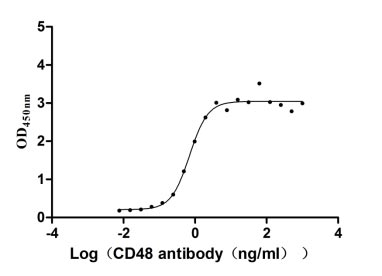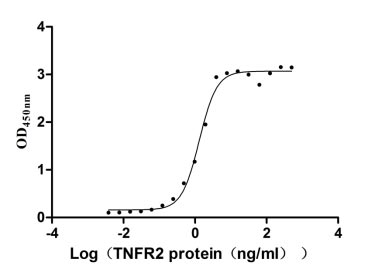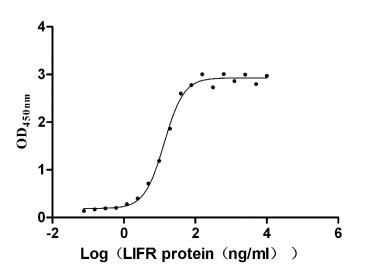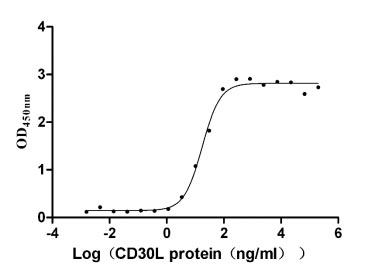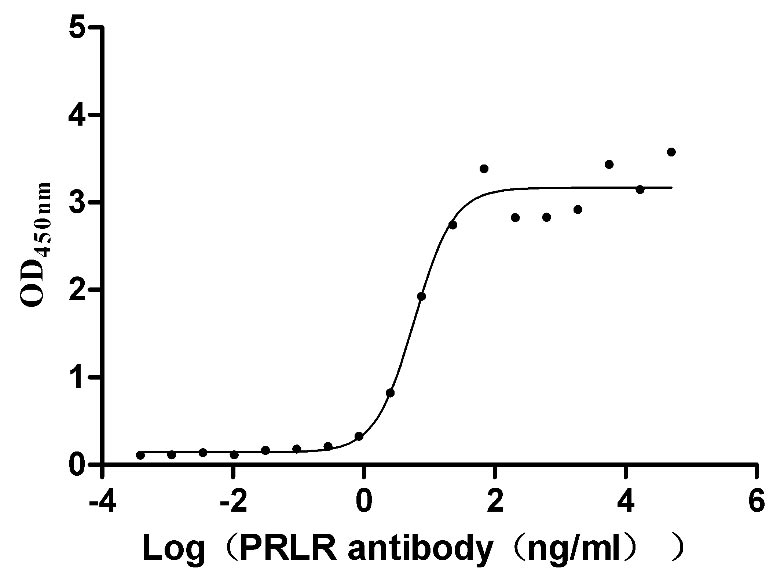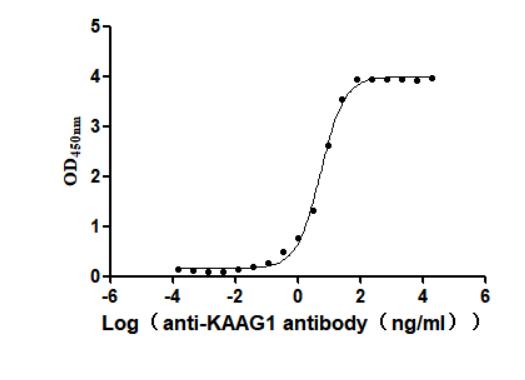Recombinant Human Nucleotide-binding oligomerization domain-containing protein 1 (NOD1), partial
-
中文名稱:人NOD1重組蛋白
-
貨號(hào):CSB-YP896866HU
-
規(guī)格:
-
來(lái)源:Yeast
-
其他:
-
中文名稱:人NOD1重組蛋白
-
貨號(hào):CSB-EP896866HU
-
規(guī)格:
-
來(lái)源:E.coli
-
其他:
-
中文名稱:人NOD1重組蛋白
-
貨號(hào):CSB-EP896866HU-B
-
規(guī)格:
-
來(lái)源:E.coli
-
共軛:Avi-tag Biotinylated
E. coli biotin ligase (BirA) is highly specific in covalently attaching biotin to the 15 amino acid AviTag peptide. This recombinant protein was biotinylated in vivo by AviTag-BirA technology, which method is BriA catalyzes amide linkage between the biotin and the specific lysine of the AviTag.
-
其他:
-
中文名稱:人NOD1重組蛋白
-
貨號(hào):CSB-BP896866HU
-
規(guī)格:
-
來(lái)源:Baculovirus
-
其他:
-
中文名稱:人NOD1重組蛋白
-
貨號(hào):CSB-MP896866HU
-
規(guī)格:
-
來(lái)源:Mammalian cell
-
其他:
產(chǎn)品詳情
-
純度:>85% (SDS-PAGE)
-
基因名:
-
Uniprot No.:
-
別名:CARD 4; CARD4; Caspase recruitment domain 4; Caspase recruitment domain containing protein 4; Caspase recruitment domain family member 4; Caspase recruitment domain protein 4; Caspase recruitment domain-containing protein 4; CLR 7.1; CLR7.1; NLR family CARD domain containing 1; NLRC 1; NLRC1; NOD 1; Nod1; NOD1 protein; NOD1_HUMAN; Nucleotide binding oligomerization domain containing 1; Nucleotide binding oligomerization domain leucine rich repeat and CARD domain containing 1; Nucleotide-binding oligomerization domain-containing protein 1; Protein Nod1
-
種屬:Homo sapiens (Human)
-
蛋白長(zhǎng)度:Partial
-
蛋白標(biāo)簽:Tag?type?will?be?determined?during?the?manufacturing?process.
The tag type will be determined during production process. If you have specified tag type, please tell us and we will develop the specified tag preferentially. -
產(chǎn)品提供形式:Lyophilized powder
Note: We will preferentially ship the format that we have in stock, however, if you have any special requirement for the format, please remark your requirement when placing the order, we will prepare according to your demand. -
復(fù)溶:We recommend that this vial be briefly centrifuged prior to opening to bring the contents to the bottom. Please reconstitute protein in deionized sterile water to a concentration of 0.1-1.0 mg/mL.We recommend to add 5-50% of glycerol (final concentration) and aliquot for long-term storage at -20℃/-80℃. Our default final concentration of glycerol is 50%. Customers could use it as reference.
-
儲(chǔ)存條件:Store at -20°C/-80°C upon receipt, aliquoting is necessary for mutiple use. Avoid repeated freeze-thaw cycles.
-
保質(zhì)期:The shelf life is related to many factors, storage state, buffer ingredients, storage temperature and the stability of the protein itself.
Generally, the shelf life of liquid form is 6 months at -20°C/-80°C. The shelf life of lyophilized form is 12 months at -20°C/-80°C. -
貨期:Delivery time may differ from different purchasing way or location, please kindly consult your local distributors for specific delivery time.Note: All of our proteins are default shipped with normal blue ice packs, if you request to ship with dry ice, please communicate with us in advance and extra fees will be charged.
-
注意事項(xiàng):Repeated freezing and thawing is not recommended. Store working aliquots at 4°C for up to one week.
-
Datasheet :Please contact us to get it.
相關(guān)產(chǎn)品
靶點(diǎn)詳情
-
功能:Enhances caspase-9-mediated apoptosis. Induces NF-kappa-B activity via RIPK2 and IKK-gamma. Confers responsiveness to intracellular bacterial lipopolysaccharides (LPS). Forms an intracellular sensing system along with ARHGEF2 for the detection of microbial effectors during cell invasion by pathogens. Required for RHOA and RIPK2 dependent NF-kappa-B signaling pathway activation upon S.flexneri cell invasion. Involved not only in sensing peptidoglycan (PGN)-derived muropeptides but also in the activation of NF-kappa-B by Shigella effector proteins IpgB2 and OspB. Recruits NLRP10 to the cell membrane following bacterial infection.
-
基因功能參考文獻(xiàn):
- Two Single-Nucleotide Polymorphisms associated with susceptibility to develop dengue in NOD1 or RIPK2 genes were observed Children from Colombia. PMID: 30332343
- our work indicates that NOD1 plays a previously undetected protective role in larval survival through CD44a-mediated activation of the PI3K-Akt signaling. PMID: 28592872
- Upregulation of miR-495 ameliorates the high glucose-induced inflammatory, cell differentiation and extracellular matrix accumulation of human CFs by modulating both the NF-kappaB and TGF-beta1/Smad signaling pathways through downregulation of NOD1 expression. PMID: 29760746
- Study proposes that NOD1 contributes to inflammation not only by promoting pro-inflammatory processes, but also by suppressing anti-inflammatory pathways. PMID: 28432285
- Overexpression of either NOD1 or NOD2 reduces cell proliferation and increases clonogenic potential in vitro in breast cancer cell lines. PMID: 29615116
- NOD1 (rs6958571) SNP was associated with gram-positive blood stream infection in Caucasian infants and extremely low birth weight infants. PMID: 28768269
- In transgenic mice expressing human NOD1 and deficient for the murine NOD1, we showed enhanced clearance of a lipl21- mutant of Leptospira interrogans compared to the complemented strain, or to what was observed in NOD1KO mice, suggesting that LipL21 facilitates escape from immune surveillance in humans. PMID: 29211798
- The changes in the nucleotide-binding oligomerization domain-like receptors (NLRs) in human corneas with disease expression may reflect different susceptibility to infectious and non-infectious injuries in corneas with various diseases. PMID: 26902715
- A role for NOD1 in HCMV control via RIPK2- IKKalpha-IRF3 signaling, NOD1 polymorphisms predict the risk of infection. PMID: 27856764
- Bronchial epithelial overexpression of TLR4 and NOD1 in severe/very severe stable COPD, associated with increased bronchial inflammation and P. aeruginosa bacterial load, may play a role in the pathogenesis of COPD PMID: 28536249
- study provides structural and dynamic insights into the NOD1-RIP2 oligomer formation, which will be crucial in understanding the molecular basis of NOD1-mediated CARD-CARD interaction in higher and lower eukaryotes PMID: 28114344
- Based on molecular docking studies using PG ligands, we propose few residues - G825, D826 and N850 in hNOD1-LRR and L904, G905, W931, L932 and S933 in hNOD2-LRR, evolutionarily conserved across different host species, which may play a major role in ligand recognition. PMID: 28673961
- Nucleotide-binding oligomerization domain (NOD1) was the most significantly associated gene when analyzing exonic rare variants (RVs) in chromosome 7p to carotid bifurcation intima-media thickness (bIMT). PMID: 27936005
- Fusion of human SGT1 (hSGT1) to NOD1 LRR significantly enhanced the solubility, and the fusion protein was stabilized by coexpression of mouse Hsp90alpha. PMID: 27591899
- the results suggest that the chronic activation of NOD1 and NOD2 receptors might play a role in the development of gastric cancer. PMID: 27917621
- this study reveals that LRRK2 is a new positive regulator of Rip2 and promotes inflammatory cytokine induction through the Nod1/2-Rip2 pathway. PMID: 27830463
- Finally, NOD1 agonist increased the formation of cranial and subintestinal vessel plexus in zebrafish, and this effect was abrogated by concurrent PPARgamma activation. Overall, these findings identify a PPARgamma-miR-125a-NOD1 signaling axis in endothelial cells that is critical in the regulation of inflammation-mediated angiogenesis. PMID: 27836539
- NOD1/2 gene variants are not linked with T2DM and IR. PMID: 27885704
- findings show that NOD1, a PRR that normally senses bacterial peptidoglycans, is activated by HCV viral polymerase, probably through an interaction with dsRNA, suggesting that NOD1 acts as an RNA ligand recognition receptor. PMID: 27099311
- Brain pericytes can sense Gram-negative bacterial products by both NOD1 and TLR4 receptors, acting through distinct pathways. PMID: 26915562
- NOD1 And NOD2 polymorphisms were associated with increased susceptibility to Guillain-Barre syndrome in a Northern Indian population. PMID: 27000222
- over-expression of NOD1 and NOD2 may be involved in the pathogenesis of Vogt-Koyanagi-Harada (VKH) Syndrome syndrome. PMID: 26980698
- Porphyromonas gingivalis induced NOD1 overexpression in endothelial cells and that NOD1 played an important role in the process of VCAM-1 and ICAM-1 expression in endothelial cells infected with Porphyromonas gingivalis through the NF-kappaB signaling pathway. PMID: 24862550
- contributes to fetal growth retardation and death through vascular inflammation PMID: 26880761
- findings illuminated a role for NOD1 signaling in attenuating H. pylori-induced Cdx2 expression in gastric epithelial cells PMID: 26759244
- NOD1/CARD4 gene may influence the diagnosis and treatment of lung cancer PMID: 26238283
- NOD1 and NOD2, two members of the NOD-like receptor family of pattern recognition receptors, are important mediators of ER-stress-induced inflammation in mouse and human cells PMID: 27007849
- NOD1 signaling results in the induction of the cellular degradation pathway of autophagy and the development of pro-inflammatory responses that activate the adaptive immune system. PMID: 25801093
- The higher NOD1 and NOD2 were observed in villi from patients who experienced recurrent spontaneous abortion compared with those who experienced a normal pregnancy. PMID: 25840495
- Activation of the innate immune pathway via NOD1 may be partially responsible for the increased systemic inflammation and insulin resistance in metabolic syndrome. PMID: 26052894
- NOD1 rs2709800, NOD2 rs718226, rs2111235, rs7205423 and interaction between rs718226 and H. pylori infection may be related to risk of gastric lesions. PMID: 25933107
- We found that RNA interference-induced Caspase-12 silencing increased NOD1, hBD1 and hBD2 expression PMID: 25503380
- Human embryonic stem cell-derived endothelial cells are TLR4 deficient but respond to bacteria via NOD1. PMID: 24690886
- A significant association of the NOD1 +32656 GG insertion variant with protection against infection with Chlamydia trachomatis has been detected [p: 0.0057; OR: 0.52]. PMID: 25854006
- Data indicate that E3 ligase RNF34 is associated with nucleotide-binding oligomerization domain-containing protein 1 (NOD1). PMID: 25012219
- These findings reveal a novel pathway whereby Helicobacter pylori CagL, via interaction with host integrins, can trigger pro-inflammatory responses independently of CagA translocation or NOD1 signalling. PMID: 23107019
- Monocyte expression and function of NOD1 and NOD2 in very preterm infants are intact and comparable/equivalent to term infants and adults. PMID: 24444388
- Endosomal membranes are sites of NOD1/NOD2-dependent signal transduction. PMID: 24832447
- NOD1 and RIP2 interact with bacterial peptidoglycan on endosomes to promote autophagy and inflammatory signaling. PMID: 24746552
- the NOD1-RIP2 signaling axis is more complex than previously assumed, that simple engagement of RIP2 is insufficient to mediate signaling PMID: 24958724
- This work reveals a role of Aggregatibacter actinomycetemcomitans outer membrane vesicles as a trigger of innate immunity via carriage of NOD1- and NOD2-active pathogen-associated molecular patterns (PAMPs). PMID: 25024364
- NOD1 has an active role in the heightened inflammatory environment associated with both experimental murine and human diabetic cardiac disease. PMID: 24934088
- Data indicate that the mutation of serine 7 does not affect nucleotide-binding oligomerization domain-containing protein 1 (NOD1) function. PMID: 24598002
- NOD1 has a role in the development of insulin resistance and inflammation in pregnancies complicated by gestational diabetes mellitus. PMID: 24829218
- The expression profile of NLRs in head and neck cancer cells differed from that seen in healthy epithelial cells. PMID: 24053487
- NOD1 priming of human dendritic cells promoted a Th2 polarization profile that involved the production of CCL17 and CCL22 in nonallergic subjects but only CCL17 in allergic patients. PMID: 24661094
- Helicobacter pylori cag pathogenicity island (cagPAI) involved in bacterial internalization and IL-8 induced responses via NOD1- and MyD88-dependent mechanisms in human biliary epithelial cells PMID: 24143223
- The Nod1/2-Rip2 axis was critical to induce optimal cytokine and chemokine responses to A. baumannii infection. PMID: 24366254
- NOD1 may have a role in mediating infection-associated inflammation PMID: 24041848
- bacterial infection-mediated activation of NOD1,2, together with IL-32gamma, can synergize the activation of eosinophils interacting with bronchial epithelial cells. PMID: 24295830
顯示更多
收起更多
-
亞細(xì)胞定位:Cytoplasm. Cell membrane. Apical cell membrane. Basolateral cell membrane. Note=Detected in the cytoplasm and at the cell membrane. Following bacterial infection, localizes to bacterial entry sites in the cell membrane. Recruited to the basolateral and apical membranes in polarized epithelial cells.
-
組織特異性:Highly expressed in adult heart, skeletal muscle, pancreas, spleen and ovary. Also detected in placenta, lung, liver, kidney, thymus, testis, small intestine and colon.
-
數(shù)據(jù)庫(kù)鏈接:
Most popular with customers
-
Recombinant Human CD48 antigen (CD48) (Active)
Express system: Mammalian cell
Species: Homo sapiens (Human)
-
Recombinant Human Tumor necrosis factor receptor superfamily member 1B (TNFRSF1B), partial (Active)
Express system: Mammalian cell
Species: Homo sapiens (Human)
-
Recombinant Human Leukemia inhibitory factor receptor (LIFR), partial (Active)
Express system: Mammalian cell
Species: Homo sapiens (Human)
-
Recombinant Human Tumor necrosis factor receptor superfamily member 8 (TNFRSF8), partial (Active)
Express system: Mammalian cell
Species: Homo sapiens (Human)
-
Recombinant Mouse Prolactin receptor (Prlr), partial (Active)
Express system: Mammalian cell
Species: Mus musculus (Mouse)
-
Recombinant Human Carcinoembryonic antigen-related cell adhesion molecule 8(CEACAM8) (Active)
Express system: Mammalian cell
Species: Homo sapiens (Human)
-
Recombinant Human Kidney-associated antigen 1(KAAG1) (Active)
Express system: Baculovirus
Species: Homo sapiens (Human)


